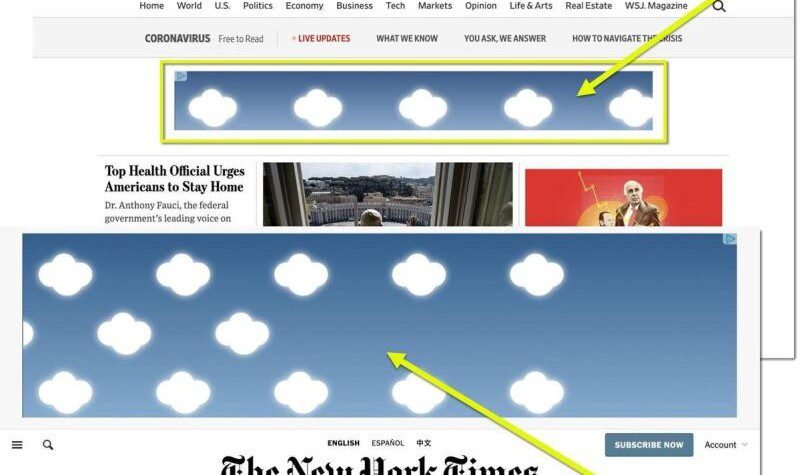
Knee-Jerk Marketers Should Pay More Attention
Most marketers are still doing knee-jerk digital marketing. They are reacting to situations without forethought, planning, or data. How do I know? The last several months gave us several juicy examples to cite. When the coronavirus pandemic hit, marketers frantically added keywords like “coronavirus” and “covid-19” to their so-called “brand safety” keyword block lists. This resulted in their ads being blocked from mainstream news sites like wsj.com and nytimes.com. The screenshots below show the blue “cloud ads” that appear when real ads are blocked from news sites for pages that contain blocked keywords.

The same thing happened again for keywords related to the Black Lives Matter and police brutality protests. Further, in the last week, dozens of major advertisers jumped on the #StopHateForProfit bandwagon to boycott advertising on Facebook, because of Facebook’s policy on hate speech on the platform and in ads. But some of these boycotts are only for the month of July. Seriously? What if Facebook doesn’t change their policies by the end of July? Would advertisers continue to pause their ad spend? What about Facebook Audience Network and all of their other digital ad spend going through programmatic ad exchanges that still fund hate sites, fake news, and disinformation? Right, not a lot of forethought or planning driven by data.
Knee-Jerk Marketers Unknowingly Fund Fake News, Hate, and Fraud Sites
By blocking their own ads on real news sites, marketers accidentally sent more of their ad budgets to lower quality sites, like fake news sites, hate sites, and fraud sites in the programmatic “long tail.” Ads shown on long-tail sites are at much higher risk of ad fraud — i.e. ads shown to bots — because those sites don’t have large human audiences and have to buy all their traffic to make ad revenue. That traffic is virtually all automated software designed to repeatedly load webpages – aka “bots.” These bots load the page to cause the ads to load, and then leave right away to load the next page. By not showing their ads on legitimate mainstream news sites, marketers missed out, because record numbers of humans were visiting real news sites during the pandemic.
Humans Pay Attention; Knee-Jerk Marketers Need to Pay More Attention
Knee-jerk marketers need to pay more attention. And I mean that both figuratively and literally. Let me explain. Humans pay “attention,” particularly on news sites because they want to be there and are actually looking at the content — and that’s desirable for advertisers, especially those doing branding campaigns. Humans have to see the ad, or else no “branding” effect takes place.
Data from Lumen Research shows the performance of display ads on Task vs Browse sites. “Task” sites include weather, dictionaries, travel booking, and retail sites where humans are doing specific tasks. “Browse” sites include magazines, social media, forums, and news sites, which humans browse. Ads shown on “browse” sites exhibit favorable characteristics across all dimensions, like viewability, % viewed, and dwell time. Note in the eye tracking heatmaps on the right side, humans “gaze” much further down the page on browse sites compared to task sites. This makes sense since people who are “on task” looking up the weather, will do the task and then leave.

Marketers who are paying attention in digital are also probably already measuring and optimizing for “viewability” which means a digital ad has the opportunity to be seen. The industry standard defines viewability as “50% of the pixels of the ad in view for 1 second.” This is a good starting point. But why not 100% of the pixels in view? Or what if the person scrolls by the ad quickly and doesn’t pay attention to it? Or what if the user was not a person at all, but a bot? Is there a better way to measure, that takes these things into account? Yes. Attention.
“Attention” Captures What Viewability, CPMs, and CTRs Don’t
Beyond just the opportunity…

















